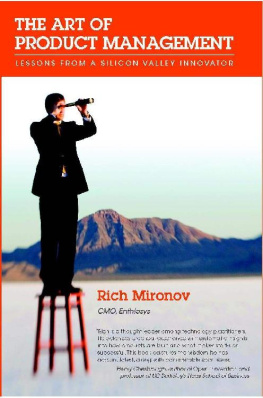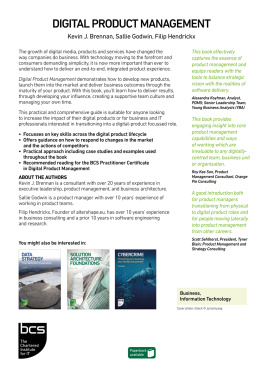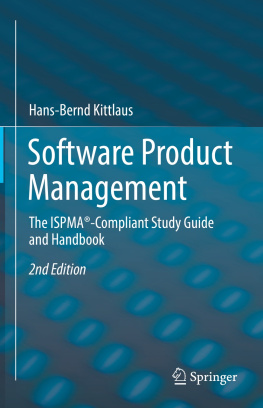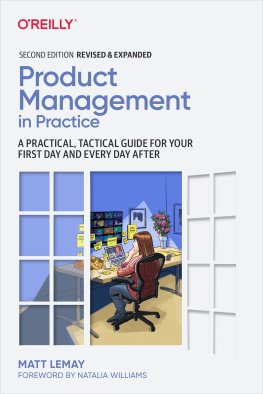THE PRODUCT MANAGERS HANDBOOK
FOURTH EDITION
LINDA GORCHELS


Copyright 2012 by Linda Gorchels. All rights reserved. Except as permitted under the United States Copyright Act of 1976, no part of this publication may be reproduced or distributed in any form or by any means, or stored in a database or retrieval system, without the prior written permission of the publisher.
ISBN: 978-0-07-177341-6
MHID: 0-07-177341-X
The material in this eBook also appears in the print version of this title: ISBN: 978-0-07-177298-3, MHID: 0-07-177298-7.
All trademarks are trademarks of their respective owners. Rather than put a trademark symbol after every occurrence of a trademarked name, we use names in an editorial fashion only, and to the benefit of the trademark owner, with no intention of infringement of the trademark. Where such designations appear in this book, they have been printed with initial caps.
McGraw-Hill eBooks are available at special quantity discounts to use as premiums and sales promotions, or for use in corporate training programs. To contact a representative please e-mail us at bulksales@mcgraw-hill.com.
This publication is designed to provide accurate and authoritative information in regard to the subject matter covered. It is sold with the understanding that neither the author nor the publisher is engaged in rendering legal, accounting, or other professional service. If legal advice or other expert assistance is required, the services of a competent professional person should be sought.
From a Declaration of Principles Jointly Adopted by a Committee of the American Bar Association and a Committee of Publishers and Association
TERMS OF USE
This is a copyrighted work and The McGraw-Hill Companies, Inc. (McGraw-Hill) and its licensors reserve all rights in and to the work. Use of this work is subject to these terms. Except as permitted under the Copyright Act of 1976 and the right to store and retrieve one copy of the work, you may not decompile, disassemble, reverse engineer, reproduce, modify, create derivative works based upon, transmit, distribute, disseminate, sell, publish or sublicense the work or any part of it without McGraw-Hills prior consent. You may use the work for your own noncommercial and personal use; any other use of the work is strictly prohibited. Your right to use the work may be terminated if you fail to comply with these terms.
THE WORK IS PROVIDED AS IS. McGRAW-HILL AND ITS LICENSORS MAKE NO GUARANTEES OR WARRANTIES AS TO THE ACCURACY, ADEQUACY OR COMPLETENESS OF OR RESULTS TO BE OBTAINED FROM USING THE WORK, INCLUDING ANY INFORMATION THAT CAN BE ACCESSED THROUGH THE WORK VIA HYPERLINK OR OTHERWISE, AND EXPRESSLY DISCLAIM ANY WARRANTY, EXPRESS OR IMPLIED, INCLUDING BUT NOT LIMITED TO IMPLIED WARRANTIES OF MERCHANTABILITY OR FITNESS FOR A PARTICULAR PURPOSE. McGraw-Hill and its licensors do not warrant or guarantee that the functions contained in the work will meet your requirements or that its operation will be uninterrupted or error free. Neither McGraw-Hill nor its licensors shall be liable to you or anyone else for any inaccuracy, error or omission, regardless of cause, in the work or for any damages resulting therefrom. McGraw-Hill has no responsibility for the content of any information accessed through the work. Under no circumstances shall McGraw-Hill and/or its licensors be liable for any indirect, incidental, special, punitive, consequential or similar damages that result from the use of or inability to use the work, even if any of them has been advised of the possibility of such damages. This limitation of liability shall apply to any claim or cause whatsoever whether such claim or cause arises in contract, tort or otherwise.
CONTENTS
Preface
This is the fourth edition of this bookand its aimed solidly at practicing product managers. While the first edition started out simply extending the discipline beyond traditional consumer packaged goods (and was primarily definitional), the next two editions began to add more fundamental tips and tools. During that 15-year period, dozens of consultants, trainers, associations, and (since 2002) LinkedIn affinity groups emerged to capitalize on the growth of product management and to expand on the basic principles. Many focus almost exclusively on an industry or niche emphasis.
So it was time for another evolutionfrom presenting product management as a fill-in-the-blank, step-by-step process to one requiring more executive, strategic thinking skills. (Yes, there are still templates and tips, but also substantial emphasis on why these templates are relevant.) Here are a few of the changes.
 This edition is organized around upstream and downstream product management responsibilities, as indicated in the books framework. As a result, there is deeper coverage of both new product development (from the perspective of a product manager rather than R&D) and product life cycle management.
This edition is organized around upstream and downstream product management responsibilities, as indicated in the books framework. As a result, there is deeper coverage of both new product development (from the perspective of a product manager rather than R&D) and product life cycle management.
 The book was cocreated with customers. End-of-chapter interviews were completed by product managers or by executives who oversee or work with product managers. Several chapters contain business briefs written by practicing product managers, demonstrating principles in use. The majority of these individuals had adapted and expanded concepts from prior editions.
The book was cocreated with customers. End-of-chapter interviews were completed by product managers or by executives who oversee or work with product managers. Several chapters contain business briefs written by practicing product managers, demonstrating principles in use. The majority of these individuals had adapted and expanded concepts from prior editions.
 Instead of a laundry list of items at the end of chapters, each chapter concludes with a single integrative, high-level, thought-provoking challenge. The more experienced the product manager, the more profound and complex the chapter challenge will be.
Instead of a laundry list of items at the end of chapters, each chapter concludes with a single integrative, high-level, thought-provoking challenge. The more experienced the product manager, the more profound and complex the chapter challenge will be.
Throughout the book, I reference several Web sites that contain videos or other explanatory material to provide greater depth of information on the topic at hand. Some of these external sources are provocative, eye-opening, or surprising, and they enable you to create your own learning package as you advance your career. Even though I have decades of experience working with thousands of product managers, one of my greatest contributions is my ability to direct you to a variety of knowledge sources beyond myself. And thats what I have tried to accomplish with this edition. Contact me (lgorchels@exed.wisc.edu) if you have any other knowledge sources worthy of sharing with product managers. Enjoy!
Acknowledgments
This book is in many ways a cocreated product based on contributions from many sources. I would specifically like to acknowledge the following. First of all, I want to thank the people who gave thoughtful answers to my interview questions and are featured at the end of each chapter. These include:
 Mark Rothwell, Vice President-Marketing Communications, Dean Clinic
Mark Rothwell, Vice President-Marketing Communications, Dean Clinic
 Scott Davis, Chief Growth Officer, Prophet
Scott Davis, Chief Growth Officer, Prophet
 Doug Vaughan, Vice President-Finance, Ingersoll-Rand
Doug Vaughan, Vice President-Finance, Ingersoll-Rand
 Paula Gray, Anthropologist-in-Residence, AIPMM
Paula Gray, Anthropologist-in-Residence, AIPMM











 This edition is organized around upstream and downstream product management responsibilities, as indicated in the books framework. As a result, there is deeper coverage of both new product development (from the perspective of a product manager rather than R&D) and product life cycle management.
This edition is organized around upstream and downstream product management responsibilities, as indicated in the books framework. As a result, there is deeper coverage of both new product development (from the perspective of a product manager rather than R&D) and product life cycle management.